Wellbeing in the Workplace: From the Floor Up
When it comes to wellbeing in the workplace it’s vital to take a holistic approach, writes Louisa Eyles, Amtico’s Commercial Marketing Manager. She explains why mind, body, and soul all have a part to play and how it starts from the floor up.
[Find Amtico on the BCFA Product Finder]
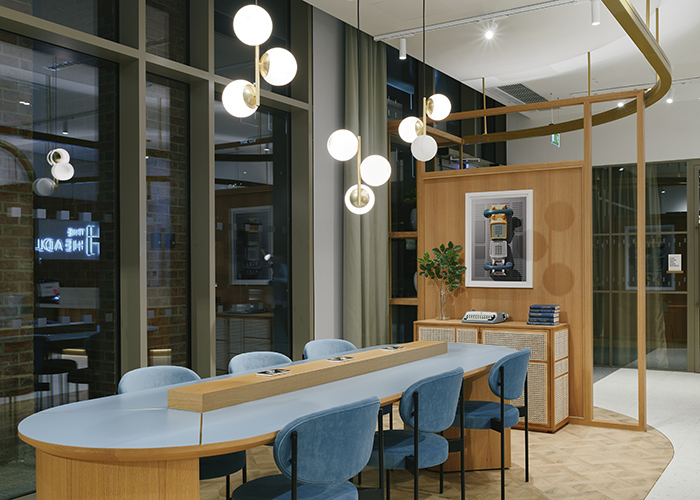
Here’s a couple of interesting facts about the relationship between health and buildings to start things off. Did you know that office workers who have a window seat sleep an average of 46 minutes longer at night? Or that hospital patients who enjoy views of nature from their windows heal more quickly? There is a wide body of research that shows how a workplace environment can affect health – both mental and physical. It’s also fair to say that a well-designed workplace can help everyone emotionally too.
The benefits of building with wellbeing firmly embedded into the design are being recognised globally. Recently the World Green Building Council released a report that outlined strong evidence on how a range of factors can make life better for occupants – not just air quality, lighting, and thermal comfort – but also the importance of the look and feel of a space, its layout and contact with nature.
So what’s this all got to do with flooring, and why are manufacturers like us at Amtico so passionate about health, wellbeing and embedding this approach from, quite literally, the ground up?
Without getting too technical, there has been some medical research done to show that there are three separate complex and functional neural networks in our bodies which broadly point to three distinct areas: brain, gut and heart. These three ‘brains’ are inextricably interlinked and work together to guide our decision making, manage our emotions and dictate our mental health.
You could say that these three neural networks actually correspond to those three age-old things we need to take care of: mind, body and soul. So how does that affect workplace wellbeing?
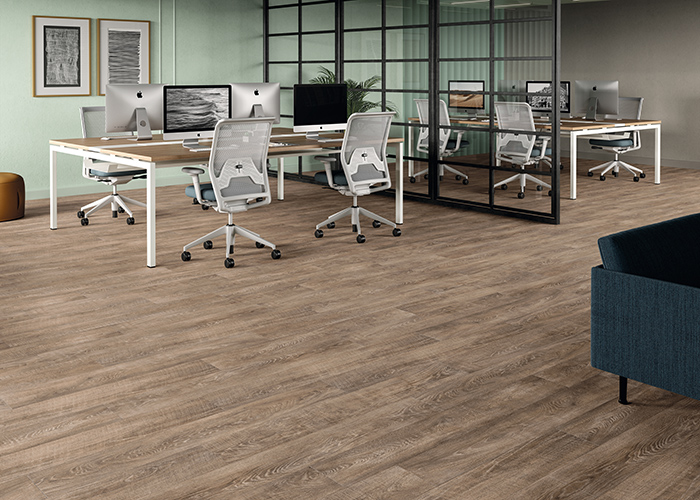
The mind
Mental health in the workplace has rightly come into focus throughout the COVID-19 pandemic – with people’s desire to work from home, as well as the impact of the office environment on mental health. It’s clear that while some people relish working from their home, others much prefer being with colleagues in a workplace.
According to Public Health England, the physical environment in the workplace has been shown “to have a powerful role in shaping a range of psychological and behaviour outcomes for employees” and that 30% of employees were troubled by their physical working environment. So how do we make it better?
From a mental health perspective, there are key fundamental principles which help keep employees happy, motivated and engaged. They include having flexible and modular spaces, activity-based ‘blended spaces’, quiet zones for more intense periods of concentration and spaces that are equipped with integrated technology.
Now, you might be wondering how flooring can assist in this. Simply put, high-quality manufactured flooring, that has been specified and laid in a way that helps to demarcate zones, will contribute to the overall look and feel of the space as well as it’s functionality.
For example, Amtico flooring was used in the multi-use amenity spaces at The Headline building in Leeds, designed by 74. The innovative use of colour and pattern enabled the spaces to be laid out in a way that was both functional and visually appealing for the build-to-rent development’s occupants. The subtle cues given by the different flooring make it clear which spaces are for collaboration and communication and which are quieter zones.
It’s clear that good design impacts workers in a positive way – boosting mental health, reducing stress and underpinning employee engagement and productivity.
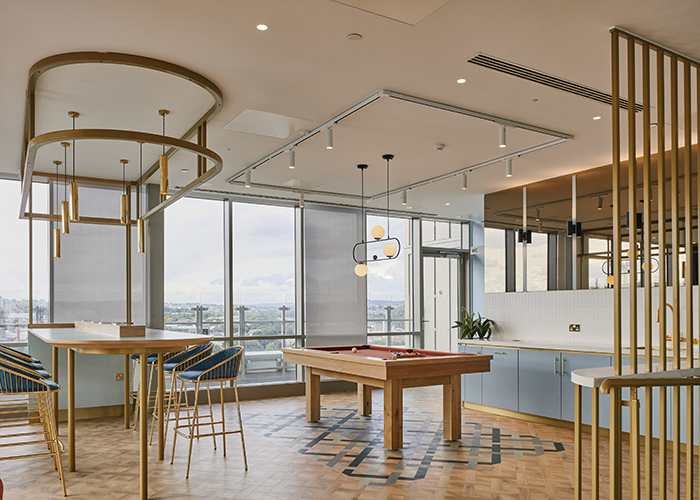
Body
Office ergonomics in open-plan offices are well-documented particularly around desk layout, screen position and cubicle space. Public Health England says that poorly designed office furniture and equipment – especially that which cannot be adjusted to suit the user – contributes to the development of musculoskeletal injuries.
That’s why, at Amtico, we believe it’s vitally important to adopt a culture of positive ergonomics. That means smart design and layout that helps people move around easily, adapt their space to suit their particular needs and ultimately keep them safe and well. Again, flooring plays a part in this. Poorly manufactured flooring, which hasn’t been laid to a good quality standard, is likely to wear quickly and ultimately become a liability. This can lead to a tripping hazard or one where the degradation of the flooring exposes the substrate below.
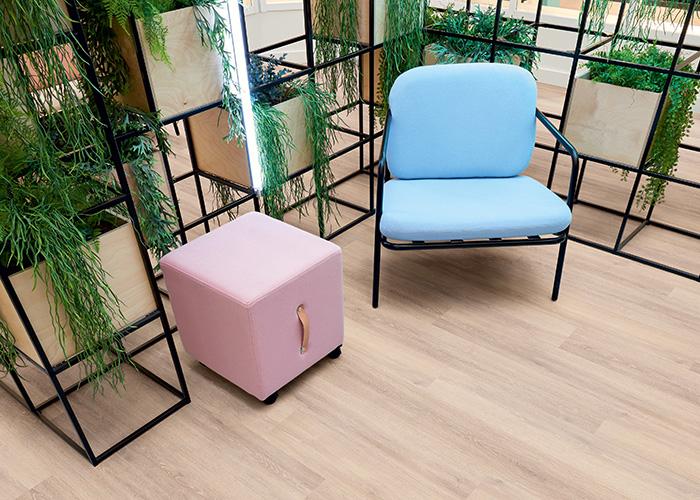
Soul
Perhaps the hardest to define and measure is our emotions – which are definitely affected by our surroundings and our workplace. Back in 1943, when contemplating post-war architecture, Sir Winston Churchill said: “We shape our buildings and afterwards our buildings shape us.” And that’s true. There’s been a lot of research about how buildings affect our feelings and moods. It’s been at the heart of some city design, as well as being incorporated by architects and interior designers.
A lot of what makes a building successful – from an emotional point of view – is giving its occupants a sense of ownership as well as a sense of direction as they move through the building. If you take the Diamond Building at the University of Sheffield as an illustration, you may remember it was a runner up in Building Design’s 2016 Carbuncle Cup for poor architecture. The judges described the interior as “wasted” and “outrageously mismanaged” making it incredibly difficult to find the way around. It sounds simple, but people love to know how to navigate a building, as well as how each area is purposed. Conversely, a building can create stress and confusion if it doesn’t factor in people’s emotions.
Again, flooring can help with navigating and defining space. A different colour or pattern can be the difference between keeping people happy or adding to their stress. For designers looking to create a sense of calm through the wellbeing benefits of biophilia, our new Spacia LVT (Luxury Vinyl Tile) flooring collection boasts an impressive 46 Woods and 48 Stones. The range has been meticulously designed to help architects, designers and specifiers deliver the kinds of floors that boost wellbeing and natural calmness.
The good news for designers is that if the right balance of function and feeling is found, it will lead to happy workplaces and, more importantly, happy workers.
Wellbeing at work is going to be a hot topic for a while, especially as employers create new ways of working and employees are looking at hybrid approaches to where and how they work post-COVID. By paying attention to details and how each building element intersects – whether flooring, lighting, surfaces, air quality or ergonomics – you’ll be able to embed wellbeing into your projects and ultimately make life better for the building’s occupants.
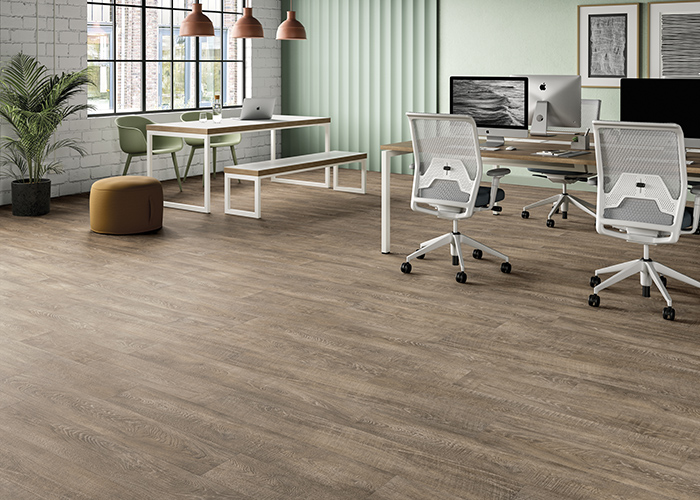
Contact Amtico on the BCFA Product Finder.
The BCFA Product Finder is a unique search engine created especially for interior designers to source contract furnishing companies. Utilising this platform will support your findings for upcoming projects, with over 200 members profiles showcasing the latest product launches, new materials available, industry news, and design trends.






Comments